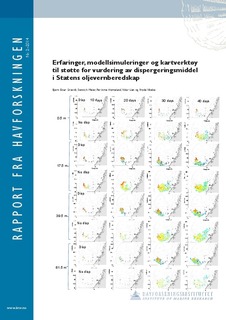| dc.contributor.author | Grøsvik, Bjørn Einar | |
| dc.contributor.author | Meier, Sonnich | |
| dc.contributor.author | Horneland, Per Arne | |
| dc.contributor.author | Lien, Vidar | |
| dc.contributor.author | Vikebø, Frode | |
| dc.date.accessioned | 2015-03-31T09:03:04Z | |
| dc.date.available | 2015-03-31T09:03:04Z | |
| dc.date.issued | 2014 | |
| dc.identifier.issn | 1893-4536 | |
| dc.identifier.uri | http://hdl.handle.net/11250/280685 | |
| dc.description.abstract | The Norwegian Coastal Administration has asked the Institute of Marine Research to present experiences, model simulations and maps of marine resources as support for decisions related to mitigation of acute oil spills. This to be better prepared for decisions related to when chemical dispersion may be used in actions to mitigate accidental oil spills. The decision to use or not use chemical dispersants to mitigate an acute oil spill is based on knowledge and experiences on which actions are considered most effective to reduce damage to the environment.
The aim of the project has been to present experiences for mitigations of acute oil spills using dispersants, and to compare model simulations of overlap of fish eggs or larvae and an oil spill with or without use of dispersants to be able to give quantitative comparisons of these alternatives.
We have updated spatial and temporary distribution of early phase stages for some fish species (North East Arctic cod, Norwegian spring spawning herring, saithe and haddock), and made available maps of vulnerable and valuable areas. This will be useful tools for identifying areas and seasons when resources are considered most vulnerable for oil exposure.
We have used model simulations of a blow out of 4500 m3 crude oil per day (Statfjord light crude) have been performed for 30 days at three locations along the Norwegian coast (The Halten bank, south of Lofoten and Vesterålen). Spawning products were released from the spawning grounds from 9 different sites, in the period from March 1st till end of April and all spawning products were followed for 60 days from the time the spill starts independent of time for spawning. The oil spill started April 1st and lasted for 30 days. We have modelled overlap between spawning products and oil concentrations giving a total PAH- concentration (TPAH) of more than 1.0 ppb (μg/l). At this concentration we expect acute mortality. In addition we have used a threshold value of TPAH of more than 0.1 ppb which is in the range were we expect sublethal effects. Model simulations were performed with or without addition of the dispersants Corexit 9500. The results showed large variations in fraction of eggs and larvae from the different spawning grounds that experienced TPAH concentrations above the selected threshold values.
Model simulations from three different oil spill scenarios showed that addition of chemical dispersant could either increase or decrease fraction of eggs and larvae that were exposed above the selected threshold value. Simulation were also performed when spawning products were introduced at the same location as the three oil spill scenarios overlap of % spawning products experiencing threshold values of above 1.0 ppb TPAH calculated. Concentrations were modelled according to vertical migration of the fish larvae. The results showed a reduction in overlap from 49 % to 46 % if dispersant were added for the oil spill scenario at the Halten Bank, a reduction in overlap from 28 % to 25 % if dispersant was added to the oil spill scenario south of Lofoten and an increase in overlap from 9 % to 11 % if the dispersant was added to the scenario at Vesterålen.
When overlap of TPAH over threshold values from the three oil scenarios were modelled for all of the 9 selected spawning grounds, a general reduction in overlap were seen if dispersants were used compared to if not used.
Results showing use of dispersants not giving dramatic differences on simulated overlap of fish larvae and oil compounds are new information to include in considerations when selecting strategies to mitigate an oil spill. Still, it is important to note that results from model simulations are dependent on input and future improvements in model resolution and new knowledge and information on critical factors, like for example threshold values may affect results and conclusion.
We have proposed parameters that should be included in environmental investigations after an oil spill | nb_NO |
| dc.publisher | Havforskningsinstituttet | nb_NO |
| dc.relation.ispartofseries | Rapport fra Havforskningen;Nr. 2 - 2014 | |
| dc.subject | oil spill | nb_NO |
| dc.subject | oljeutslipp | nb_NO |
| dc.title | Erfaringer, modellsimuleringer og kartverktøy til støtte for vurdering av dispergeringsmiddel i Statens oljevernberedskap | nb_NO |
| dc.title.alternative | Experiences, model simulations and maps of marine resources as support for decisions related to mitigation of acute oil spills | nb_NO |
| dc.type | Working paper | nb_NO |
| dc.subject.nsi | VDP::Mathematics and natural science: 400::Zoology and botany: 480::Ecotoxicology: 489 | nb_NO |
| dc.subject.nsi | VDP::Mathematics and natural science: 400::Zoology and botany: 480::Marine biology: 497 | nb_NO |
| dc.source.pagenumber | 35 s. | nb_NO |
